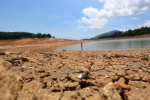
Rain storms, Warming ocean, ocean rain storms (Photo: IANS)
May 27,2020
Sydney: Even though the deeper layers of the ocean are warming at a slower pace than the surface, animals living in the deep ocean are more exposed to climate warming and will face increasing challenges to maintain their preferred thermal habitats in the future, warn researchers.
The study led by the University of Queensland in Australia and published in the Nature Climate Change, looked at how ocean life was responding to climate change.
“We used a metric known as climate velocity which defines the likely speed and direction a species shifts as the ocean warms,” said study researcher Isaac Brito-Morales.
The international team of researchers calculated the climate velocity throughout the ocean for the past 50 years and then for the rest of this century using data from 11 climate models.
“This allowed us to compare climate velocity in four ocean depth zones – assessing in which zones biodiversity could shift their distribution the most in response to climate change,” Brito-Morales said.
The researchers found climate velocity is currently twice as fast at the surface because of greater surface warming, and as a result, deeper-living species are less likely to be at risk from climate change than those at the surface.
“However by the end of the century, assuming we have a high-emissions future, there is not only much greater surface warming but also this warmth will penetrate deeper,” Brito-Morales said.
In waters between a depth of 200 and 1000 metres, The research showed climate velocities accelerated to 11 times the present rate.
“And in an interesting twist, not only is climate velocity moving at different speeds at different depths in the ocean, but also in different directions which poses huge challenges to the ways we design protected areas,” Brito-Morales added.
The research team believed action must be taken to aggressively manage carbon emissions.
“Significantly reducing carbon emissions is vital to control warming and to help take control of climate velocities in the surface layers of the ocean by 2100,” said study researcher Anthony Richardson.
“But because of the immense size and depth of the ocean, warming already absorbed at the ocean surface will mix into deeper waters,” he added.
This means that marine life in the deep ocean will face escalating threats from ocean warming until the end of the century, no matter what we do now.
“This leaves only one option – act urgently to alleviate other human-generated threats to deep-sea life, including seabed mining and deep-sea bottom fishing,” the authors wrote. IANS



















